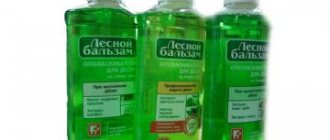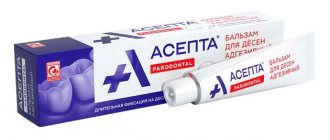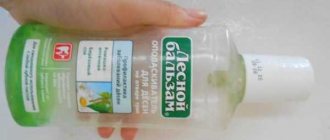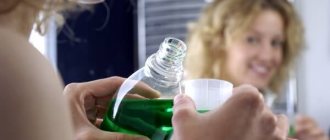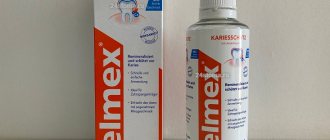Gingivitis and periodontitis are the most common gum diseases.
This is a problem that dentists face almost daily. According to statistics, certain signs of gum disease are observed in 95% of the population. The pathology is especially common in patients over 30 years of age. The disease not only brings discomfort and discomfort, but over time can cause tooth loss. What are its symptoms and what needs to be done to prevent the development of the disease?
Gum diseases and their symptoms
Depending on the location of inflammation, there are:
- Gingivitis is an inflammatory process that appears on the gums around the tooth, but does not affect the dental tissues. This is a milder form of the disease. Manifested by redness, swelling, discomfort, bleeding. It can occur in acute and chronic form.
- Periodontitis is one of the most insidious pathologies. As it develops, inflammation spreads to the supporting apparatus of the tooth. This is already stage II of the disease. At this time, bad breath appears, the gums become loose and, due to their receding, the teeth appear longer. In areas of inflammation, pus may appear when pressure is applied.
If left untreated, periodontal disease develops (stage III), which is extremely difficult to treat and brings a lot of suffering to the patient. To prevent the development of the disease, you must immediately consult a doctor at its first signs.
Causes of bleeding from gums
Injury to gum tissue
The mucous membrane of the gums can be damaged when brushing your teeth with a brush that is too hard or if used incorrectly:
- dental floss,
- toothpicks,
- and other hygiene products,
- when eating too rough food (hard cookies, crackers).
More serious bleeding may be caused by improper fitting of prosthetic devices (crowns, bridges, etc.).
Poor hygiene
In the absence of the required care, a plaque consisting of bacteria, mucus and food debris appears on the enamel. Subsequently, it is mineralized by calcium salts present in saliva and turns into dense tartar. The bacteria that make up plaque produce toxins that negatively affect the condition of the mucous epithelium of the gums and provoke the development of an inflammatory reaction. Against the background of inflammation, the blood vessels in the gum tissue become vulnerable, brittle and easily injured when eating or performing hygiene measures.
Irritation from tobacco product toxins
Irritation that occurs upon contact with chemicals. In particular, bleeding can be caused by toxins produced by burning tobacco or smoking mixtures. In addition, chemical irritants can be substances used in hazardous industries (asbestos, metal salts, perchlorethylene) or poorly selected hygiene products (pastes, rinses).
Hormonal imbalances
Hormonal changes are one of the most common causes of bleeding gums in pregnant women. Such manifestations are temporary: bleeding stops completely after the baby is born.
In addition, factors contributing to the development of bleeding gums are:
- unbalanced diet;
- serious disorders in the functioning of the body (leukemia, diabetes, hemophilia and others);
- long-term medication use;
- lack of vitamins;
- drinking alcohol too often;
- stress.
Comprehensive treatment measures
Therapy consists of several stages:
- Professional teeth cleaning Removing dental plaque is one of the important therapeutic stages. During the procedure, plaque and tartar are removed, which helps restore the gums to their previous position. For professional teeth cleaning, the Air Flow device is used in most cases. This is a safe way to gently clean without damaging the enamel. During the procedure, a mixture of water, soda and air is sprayed onto the teeth under pressure. The device allows you to remove various types of deposits, which is very important during treatment. To perform the ultrasonic teeth cleaning procedure, a special device is used that produces ultrasonic waves. With the help of ultrasound, it is possible to remove tartar even in subgingival pockets. After removing tartar, fluoridation is performed. The teeth are coated with special preparations containing fluoride and calcium. They allow you to saturate the enamel with minerals and make it more durable. And also relieve increased sensitivity of the necks and roots of the teeth.
- Anti-inflammatory therapy Considering that the gums remain inflamed and bleeding after the teeth are freed from deposits, antiseptics and a number of other drugs are prescribed. Used in the form of: - rinses; - oral baths; — applications to the pathological periodontal pocket; - submucosal injections. Physiotherapeutic procedures (electrophoresis, phonophoresis) are also often used. Laser therapy has become widespread. The procedure helps relieve pain, improve blood circulation and metabolism, and stimulate immune defense. In severe cases, antimicrobial and anti-inflammatory drugs are prescribed orally or as intramuscular injections. The periodontist or the patient himself massages the gums. The area of the interdental gum papilla is massaged with the index finger in an up and down motion. Finish the massage with hygienic rinses.
- Surgical treatment Used in severe cases of the disease, when the inflammatory process has spread deep into the bone tissue. Today, there are various surgical treatment methods, the choice of which depends on the condition of the patient’s oral cavity and his overall health.
Indications for use
You should know! Refer to the instructions on the back of the bottle for recommendations for use.
Most often, dentists recommend using Forest Balm for:
- Prevention of diseases of the teeth and oral mucosa.
- Eliminate pathogenic bacteria.
- Maintaining local immunity after surgery.
- Acceleration of regenerative processes of mucous tissues.
Prevention
It is quite possible to protect your gums and teeth from an unpleasant disease if you follow a number of simple rules:
- Visit the dentist 2 times a year. The specialist will identify the disease in the initial stages, which will greatly facilitate treatment. Visits to the doctor will help to diagnose caries in a timely manner and replace low-quality fillings. After all, one of the causes of periodontitis is pathogenic microorganisms and uneven fillings.
- Maintaining oral hygiene at home is another important preventive measure. Brushing your teeth in the morning and evening with a medium-hard brush will help avoid periodontitis. As additional care products, it is necessary to use dental floss, tongue cleaner, and rinses. It is very important to choose the right toothpaste. If you find it difficult to choose, consult your doctor. Perhaps a specialist will recommend a specific paste - with fluoride or medicinal herbs.
- Eating right helps prevent disease by eating solid foods, which put stress on the teeth and gums, strengthening them. The diet should contain vegetables and fruits, dairy products (preferably without sugar), fish and meat.
Prevention does not require special efforts; only a systematic and comprehensive approach is important. And then a reliable barrier will be erected between you and the disease.
Complex dentistry "Sanident", providing services in the urban district of Shchelkovo and Ivanteevka, invites you to undergo a free examination, which will help identify dental pathology at an early stage of development and quickly eliminate it. For treatment, we use modern materials and high-quality painkillers, which allows patients to feel as comfortable as possible during any procedure. Equipping the clinic with the most modern and advanced equipment allows for effective treatment of any dental disease.
We pay special attention to quality and service and strive to ensure that anyone can use our services. Therefore, our prices for dental treatment are affordable, promotions are often held, and discounts apply.
The specialists of the Sanident dental clinic are ready to help right now. Use the consultation registration form on our website.
Choosing the best mouthwash for teeth and gums
Modern rinses are available in the form of ready-made solutions, liquid concentrates, or in the form of powders that must be diluted with water. They can be hygienic for refreshing the oral cavity and therapeutic and prophylactic against caries, inflammation, bleeding gums and for strengthening tooth enamel.
For daily use, you should choose a liquid without an antibacterial component in the composition. A gum rinse with an antibacterial component (triclosan, chlorhexidine) helps with acute inflammation (ulcers, gum inflammation, aphthae). But it is worth considering that it cannot be used for more than 7 days in a row, because the native microflora of the oral cavity begins to die, it is replaced by pathogenic bacteria that produce resistance factors to triclosan and chlorhexidine, and become the enemy of your body. Dry mucous membranes and increased tissue irritability may appear.
You also need to pay attention to the fluoride content: with a content of no more than 0.05%, the liquid can be used daily without harm. If the fluoride concentration is 0.2% or higher, dentists advise using this rinse no more than 1-2 times a week.
The product for sensitive teeth that react to cold and hot should not contain alcohol. Ethyl alcohol can negatively affect the condition of the oral mucosa. Motorists should also note that such a mouthwash can give a positive result on a breathalyzer, although the normal level of ethyl alcohol in the breath returns within 10 minutes after rinsing the mouth.
It is worth saying that the color of the liquid does not affect the change in the color of tooth enamel, that is, staining does not occur even after prolonged use of the mouthwash. Therefore, when choosing a rinse aid, you do not need to focus on the color of the solution.
When choosing an oral fluid, pay attention to criteria such as:
- clinically proven effectiveness;
- products are approved by the Russian Dental Association.
For example, Asepta® brand mouth rinses meet these criteria. The line of products includes two combined-action rinses - the hygienic Asepta® Fresh and the therapeutic and preventive Asepta® Active.
Mouthwash "Asepta® Active" is intended for use in infectious and inflammatory diseases of the oral cavity. It has an antibacterial effect, relieves inflammation and bleeding of gums due to gingivitis and periodontitis, prevents the formation of dental plaque and freshens breath. The liquid also has an analgesic effect, since it contains an analgesic - benzydamine, therefore it is indicated for toothache.
Asepta® Fresh mouthwash does not contain alcohol or antiseptics and is recommended for daily preventive protection and maintaining healthy gums and teeth. The product reduces the increased sensitivity of teeth and gums, prevents the formation of tartar and caries.
Mouthwash for bleeding gums
When bleeding gums, rinses with plant extracts help well. Extracts of plants such as chamomile, sage, lemon balm, St. John's wort, oak bark have a pronounced healing effect, help cope with bleeding and strengthen gums, and have a wound healing effect. Chamomile improves blood circulation and has a positive effect on blood vessels, preventing bleeding.
Plant extracts also help achieve fresh breath.
Mouthwash for gum inflammation
Anti-inflammatory rinses contain components such as plant essential oils, antiseptics, and antioxidants. Chlorhexidine is a broad-spectrum antiseptic, most often used in anti-inflammatory rinses. As mentioned above, the course of use of such rinses is limited and must be agreed with a doctor so as not to upset the balance of the oral microflora.
The rinse may also contain betamethasone as an anti-inflammatory component.
Mouthwash against caries
Anti-caries agents contain minerals (fluorine, calcium), which are aimed at strengthening tooth enamel and preventing caries. Fluoride rinses are suitable for daily use as long as the fluoride concentration is low. The British Dental Association recommends the use of fluoridated rinses as an addition to brushing with fluoridated toothpastes, which provide a higher level of protection than using toothpaste alone.
How to use mouthwash for oral hygiene?
Rinsing with mouthwash should be done at least twice a day, after brushing and flossing your teeth. It is recommended to use the rinse also after meals during the day as an independent means of oral hygiene.
Many mouthwash bottles have a special dispenser cap that holds approximately 4 teaspoons of product, which is equal to 20 g of liquid. If there is no measuring cap, a dose equivalent to 20 g of liquid is used.
To achieve the effect, you need to rinse your mouth with the liquid for at least 20 seconds. Dentists recommend rinsing your mouth dynamically, as if filtering the liquid through your teeth. The liquid is then spat out. After the procedure, it is advisable to refrain from eating and drinking for half an hour to allow the healing, antiseptic and mineralizing components to take effect.
Rinse aids are not intended to be diluted with water or mixed with other products.
If you experience a burning sensation in your mucous membranes when using a mouthwash, you should choose another oral hygiene product.
Let's summarize: using mouthwash for daily oral hygiene is not only possible, but also necessary. For daily use, a product without an antibacterial component and with a low fluoride content is suitable. By regularly using mouth rinse as the final stage of hygiene, you will ensure reliable protection of your teeth from plaque and caries, and gums from inflammatory diseases, and avoid bad breath.
May your teeth be healthy!
Consumer Reviews
An excellent combination of price and quality, natural composition and effectiveness - these components have brought the Forest Balsam mouthwash great popularity among the population.
Let's see what consumers say:
Ekaterina Plotnik, 39 years old.
My husband had terrible gum problems. This is likely due to the fact that he is a heavy smoker.
Every morning, while brushing his teeth, he spat out bloody saliva. On the advice of the dentist, we bought “Forest Balm” from the “For Bleeding Gums” series and it really helped.
Already on the third use, the husband noted that the gums practically did not bleed. Moreover, its enamel became a little lighter. Now we use the rinse and toothpaste “Forest Balsam” with the whole family.
Elena Gordeychik, 31 years old.
I can’t imagine my morning without a cup of strong black coffee, and my lunch without a big glass of latte.
Unfortunately, my addiction to coffee drinks also affected the condition of the enamel - my teeth became noticeably yellower.
Having secured a whitening toothpaste, I began to look for a suitable rinse and my choice fell on “Triple Effect Whitening” from “Forest Balm”.
I was seduced by the natural and harmless composition. The mouthwash works well - my teeth actually became several shades whiter, and there was practically no plaque left.
I think I will continue to use it even after the whitening course.
Instructions for use
Important! Forest Balm should be used twice a day, after morning and evening brushing of teeth.
The instructions are as follows:
- Brush your teeth with a brush. Try to remove plaque and get rid of food debris. It would be a good idea to clean the surface of your tongue.
- Spit out the paste and rinse your mouth with water .
- Fill the balm cap about 3/4 full . Place the liquid in your mouth and rinse thoroughly for several minutes. The rinse should wash the inside of the cheeks, tongue and interdental spaces.
Note! In 95% of cases, consumers feel positive dynamics after a week of regular use.
Gums stop bleeding when brushing, and the enamel reacts less to the use of hot and cold.
